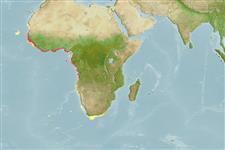Elasmobranchii (hajar och rockor) (sharks and rays) >
Carcharhiniformes (Ground sharks) >
Hemigaleidae (Weasel sharks)
Etymology: Paragaleus: para (Gr.), near, referring to how its dentition is intermediate between Hemigaleus and the triakid Eugaleus (=Galeorhinus). (See ETYFish); pectoralis: Latin for pectoral, allusion not explained, possibly referring to its characteristic falciform pectoral fins. (See ETYFish).
More on author: Garman.
Environment: milieu / climate zone / depth range / distribution range
Ekologi
marina bottenlevande; djupintervall ? - 100 m (Ref. 5578), usually 30 - 70 m (Ref. 10730). Tropical; 30°N -
Eastern Atlantic: Cape Verde and Mauritania to northern Namibia (Ref. 244, 5578); possibly extending north to Morocco. Record from the Northwest Atlantic, specifically in New England, has not been verified even after an extensive survey of the area has been conducted.
Length at first maturity / Size / Vikt / Age
Maturity: Lm 82.5, range 75 - 90 cm
Max length : 140 cm TL hane/ej könsbestämd; (Ref. 5578); common length : 100.0 cm TL hane/ej könsbestämd; (Ref. 26999)
Short description
Bestämningsnycklar | Morfologi | Morfometri
Taggstrålar i ryggfenan (totalt) : 0; Taggstrålar i analfenan: 0. A slender weasel shark with a moderately long snout, large eyes, and a short, small mouth with small, serrated upper teeth and erect-cusped lower teeth (Ref. 5578). Light grey or bronze with longitudinal yellow stripes, fins plain; white below (Ref. 5578).
A very common inshore to offshore shark of the continental shelf occurring at depths of a few meters to slightly over 100 m (Ref. 244). A specialist feeder that prefers cephalopods, also feeds on small bony fishes (Ref. 244). Viviparous (Ref. 50449). Utilized fresh and dried salted for human consumption, and processed into fishmeal (Ref. 244).
Viviparous (with a yolk-sac placenta), with 1 to 4 young per litter. Size at birth about 47 cm (Ref. 244). Distinct pairing with embrace (Ref. 205).
Compagno, L.J.V., 1984. FAO Species Catalogue. Vol. 4. Sharks of the world. An annotated and illustrated catalogue of shark species known to date. Part 2 - Carcharhiniformes. FAO Fish. Synop. 125(4/2):251-655. Rome: FAO. (Ref. 244)
IUCN Red List Status (Ref. 130435)
Threat to humans
Harmless
Human uses
Fiskeri: kommersiell
Verktyg
Special reports
Download XML
Internet-källor
Estimates based on models
Preferred temperature (Ref.
123201): 17.7 - 25.9, mean 19.9 °C (based on 45 cells).
Phylogenetic diversity index (Ref.
82804): PD
50 = 0.5664 [Uniqueness, from 0.5 = low to 2.0 = high].
Bayesian length-weight: a=0.00363 (0.00147 - 0.00899), b=3.07 (2.86 - 3.28), in cm total length, based on LWR estimates for this (Sub)family-body shape (Ref.
93245).
Trofisk nivå (Ref.
69278): 4.3 ±0.64 se; based on food items.
Resiliens (Ref.
120179): Mycket låg, lägsta populationsfördubblingstid mer än 14 år (Fec=1).
Fishing Vulnerability (Ref.
59153): Very high vulnerability (84 of 100).
